Post-Impact Behaviour of Pseudo-Ductile Thin-Ply Angle-Ply Hybrid Composites
Abstract
:1. Introduction
2. Materials and Specimens
3. Experimental Activity
3.1. Methodology Overview
3.2. Indentation Tests
- an elastic deformation region, between 0 and 750 N
- a damage initiation and evolution region, identifiable with a slope change in the force-displacement curve between 750 and the sudden load drop around 1300 N
- final indenter penetration region
3.3. Impact Tests
3.4. Post-Indentation and Post-Impact Damage Analysis
3.5. Tensile Tests
3.5.1. Benchmark Tensile Test Results
- an initial linear elastic region up to the pseudo-yield point
- a short plateau, with constant stress where fragmentation occurs
- a pseudo-plastic region, with continuous increment of the stress, where angle re-orientation in the material occurs, up to the peak of stress
- stress reduction towards the complete failure of the laminate
3.5.2. Post-Indentation Tensile Test Results
3.5.3. Post-Impact Tensile Test Results
4. Discussion
5. Conclusions
- in both indentation and impact tests, a good repeatability of the force-displacement curves was shown. Moreover, while the different pre-damaging tests caused changes in the absorbed energy, the maximum applied force remained almost the same for the fully indented and all the impacted specimens.
- the C-scan analysis showed the damage area, specifically delamination, obtained as a consequence of indentation and impact. The damage area progressively increased as the impact and absorbed energy increased; however, it was restrained by the ad hoc designed clamping system.
- a 3.9% pseudo-ductile strain was obtained for the benchmark [±277/0]S thin-ply angle-ply hybrid carbon fibre laminates.
- in both post-indentation and post-impact tensile tests, the investigated lay-up displayed a residual pseudo-ductile behaviour:
- ○
- the indented specimens displayed a global pseudo-ductile behaviour. Pseudo-ductile strains of 2.9% and 0.7 % were achieved in the Indented Interrupted (Ind_Int) and Indented Fully Damaged (Ind_FD) specimens, respectively.
- ○
- for the post-impact specimens, no global pseudo-ductile behaviour was observed. However, the DIC analysis showed that, locally, the strain exceeded the pseudo-yield strain calculated from the benchmark test, meaning that a pseudo-ductile behaviour was achieved also for this pre-damage configuration near the hole.
Author Contributions
Funding
Conflicts of Interest
References
- Jalalvand, M.; Czél, G.; Wisnom, M.R. Parametric study of failure mechanisms and optimal configurations of pseudo-ductile thin-ply UD hybrid composites. Compos. Part A 2015, 74, 123–131. [Google Scholar] [CrossRef] [Green Version]
- Jalalvand, M.; Czél, G.; Wisnom, M.R. Numerical modelling of the damage modes in UD thin carbon/glass hybrid laminates. Compos. Sci. Technol. 2014, 94, 39–47. [Google Scholar] [CrossRef] [Green Version]
- Czél, G.; Rev, T.; Jalalvand, M.; Fotouhi, M.; Longana, M.L.; Nixon-Pearson, O.; Wisnom, M.R. Pseudo-ductility and reduced notch sensitivity in multidirectional all-carbon/epoxy thin-ply hybrid composites. Compos. Part A 2018, 104, 151–164. [Google Scholar] [CrossRef]
- Yu, H.; Longana, M.L.; Jalalvand, M.; Wisnom, M.R.; Potter, K.D. Pseudo-ductility in intermingled carbon/glass hybrid composites with highly aligned discontinuous fibres. Compos. Part A 2015, 73, 35–44. [Google Scholar] [CrossRef] [Green Version]
- Finley, J.; Yu, H.; Longana, M.L.; Pimenta, S.; Shaffer, M.; Potter, K.D. Exploring the pseudo-ductility of aligned hybrid discontinuous composites using controlled fibre-type arrangements. Compos. Part A 2018, 107, 592–606. [Google Scholar] [CrossRef]
- Longana, M.L.; Yu, H.; Jalalvand, M.; Wisnom, M.R.; Potter, K.D. Aligned discontinuous intermingled reclaimed/virgin carbon fibre composites for high performance and pseudo-ductile behaviour in interlaminated carbon-glass hybrids. Compos. Part A 2017, 143, 13–21. [Google Scholar] [CrossRef] [Green Version]
- Fuller, J.D.; Wisnom, M.R. Exploration of the potential for pseudo-ductility in thin ply CFRP angle-ply laminates via an analytical method. Compos. Sci. Technol. 2015, 112, 2–15. [Google Scholar] [CrossRef]
- Fuller, J.D.; Wisnom, M.R. Pseudo-ductility and damage suppression in thin ply CFRP angle-ply laminates. Compos. Part A 2015, 69, 64–71. [Google Scholar] [CrossRef] [Green Version]
- Yuan, Y.; Yao, X.; Liu, B.; Yang, H.; Imtiaz, H. Failure modes and strength prediction of thin ply CFRP angle-ply laminates. Compos. Struct. 2017, 176, 64–71. [Google Scholar] [CrossRef]
- Yuan, Y.; Wang, S.; Yang, H.; Yao, H.; Liu, B. Analysis of pseudo-ductility in thin-ply carbon fiber angle-ply laminates. Compos. Struct. 2017, 180, 876–882. [Google Scholar] [CrossRef]
- Fuller, J.D.; Wisnom, M.R. Ductility and pseudo-ductility of thin ply angle-ply CFRP laminates under quasi-static cyclic loading. Compos. Part A 2018, 107, 31–38. [Google Scholar] [CrossRef]
- Wu, X.; Fuller, J.D.; Longana, M.L.; Wisnom, M.R. Reduced notch sensitivity in pseudo-ductile CFRP thin ply angle-ply laminates with central 0° plies. Compos. Part A 2018, 111, 62–72. [Google Scholar] [CrossRef]
- Kim, H.; Welch, D.; Kedward, K. Experimental investigation of high velocity ice impacts on woven carbon/epoxy composite panels. Compos. Part A 2003, 34, 25–41. [Google Scholar] [CrossRef]
- Fotouhi, M.; Jalalvand, M.; Prato, A.; Wisnom, M.R. Thin ply carbon/glass hybrid laminates to activate new damage mechanisms under indentation. In Proceedings of the 21st European Conference on Composite Materials (ECCM2018), Athens, Greece, 25–28 June 2018. [Google Scholar]
- Naik, N.; Ramasimha, R.; Arya, H.; Prabhu, S.; Shama Rao, N. Impact response and damage tolerance characteristics of glass-carbon/epoxy hybrid composite plates. Compos. Part B 2001, 32, 565–574. [Google Scholar] [CrossRef]
- Kounain, M.; Al-Sulaiman, F.; Khan, Z. Low velocity impact and post impact tensile properties of plain weave woven GFRP composite laminates. IJEAT 2015, 5, 92–99. [Google Scholar]
- Wu, X.; Fuller, J.D.; Wisnom, M.R. Combining the non-linearity of angle-plies and fibre fragmentation in carbon fibre laminates under compressive loading. In Proceedings of the 21st International Conference on Composite Materials (ICCM2017), Xi’an, China, 20–25 August 2017. [Google Scholar]
- Czél, G.; Jalalvand, M.; Wisnom, M.R. Design and characterisation of advanced pseudo-ductile unidirectional thin-ply carbon/epoxy glass/epoxy hybrid composites. Compos. Struct. 2016, 143, 362370. [Google Scholar] [CrossRef]
- Compressive Residual Strength Properties of Damaged Polymer Matrix Composite Plates; ASTM D7137/D7137M-07; ASTM International: West Conshohocken, PA, USA, 2007.
- Standard Test Method for Tensile Properties of Polymer Matrix Composite Materials; ASTM D3039/D3039M-08; ASTM International: West Conshohocken, PA, USA, 2008.
- Standard Test Method for Open-Hole Tensile Strength of Polymer Matrix Composite Laminates; ASTM D5766/D5766M-11; ASTM International: West Conshohocken, PA, USA, 2011.
- Standard Test Method for Measuring the Damage Resistance of a Fiber Reinforced Polymer-Matrix Composite to a Concentrated Quasi-Static Indentation Force; ASTM D6264/D6264M-17; ASTM International: West Conshohocken, PA, USA, 2017.
- Standard Test Method for Measuring the Damage Resistance of a Fiber Reinforced Polymer Matrix Composite to a Drop-Weight Impact Event; ASTM D7136/D7136M-15; ASTM International: West Conshohocken, PA, USA, 2015.
- Prato, A.; Longana, M.L. A novel approach for the investigation of low energy ice impacts. Int. J. Impact Eng. 2018, 121, 12–19. [Google Scholar] [CrossRef]


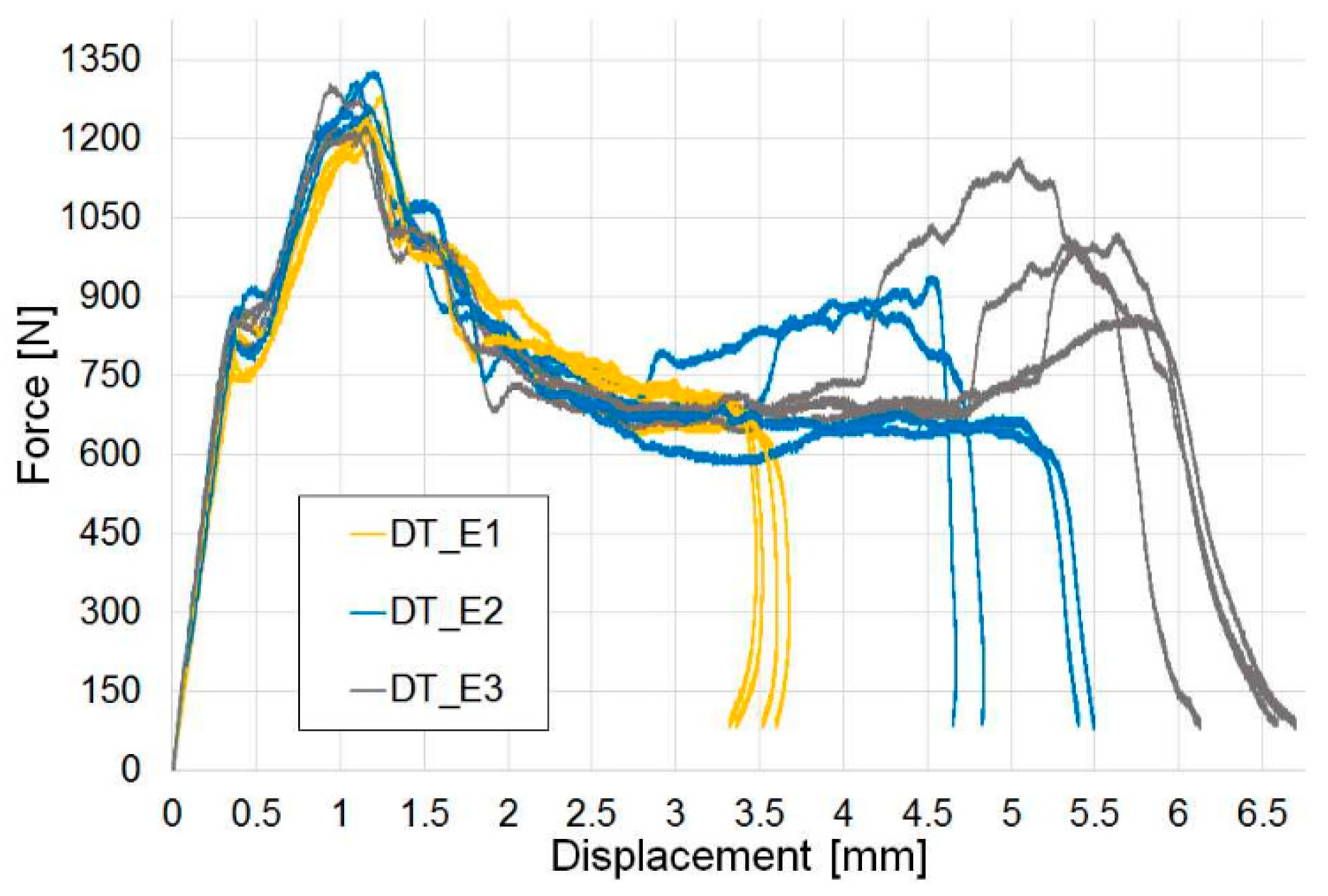
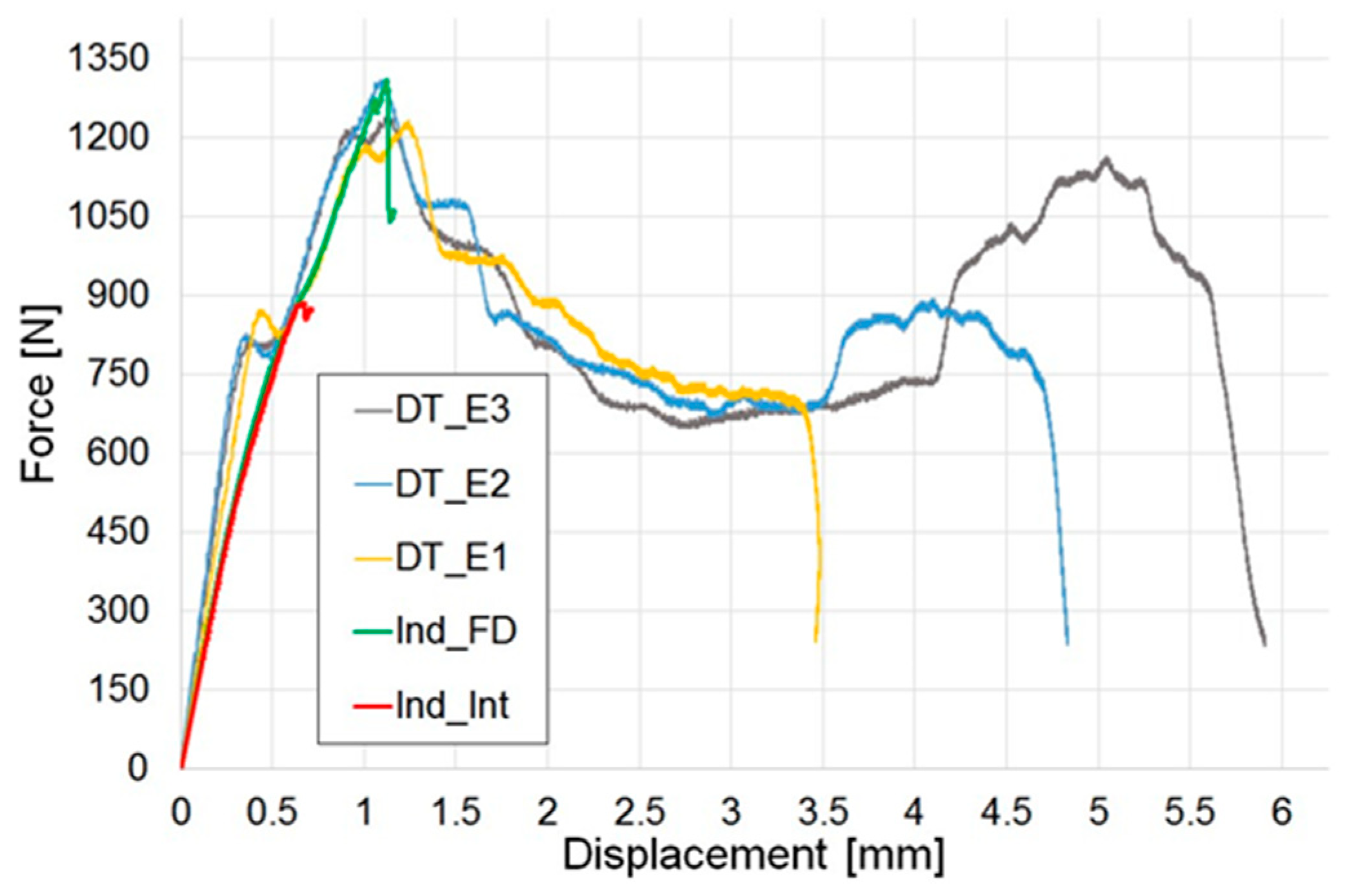
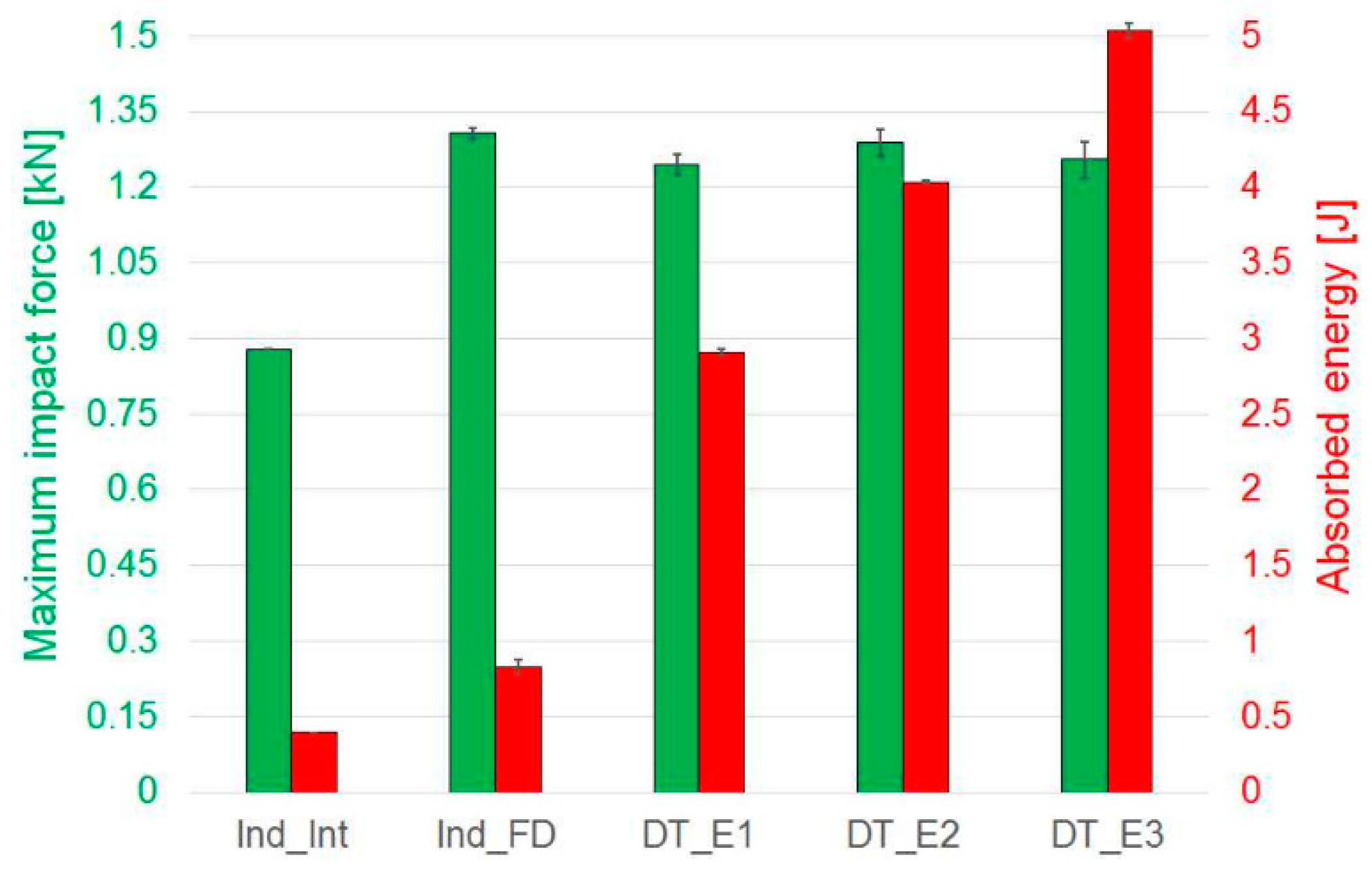
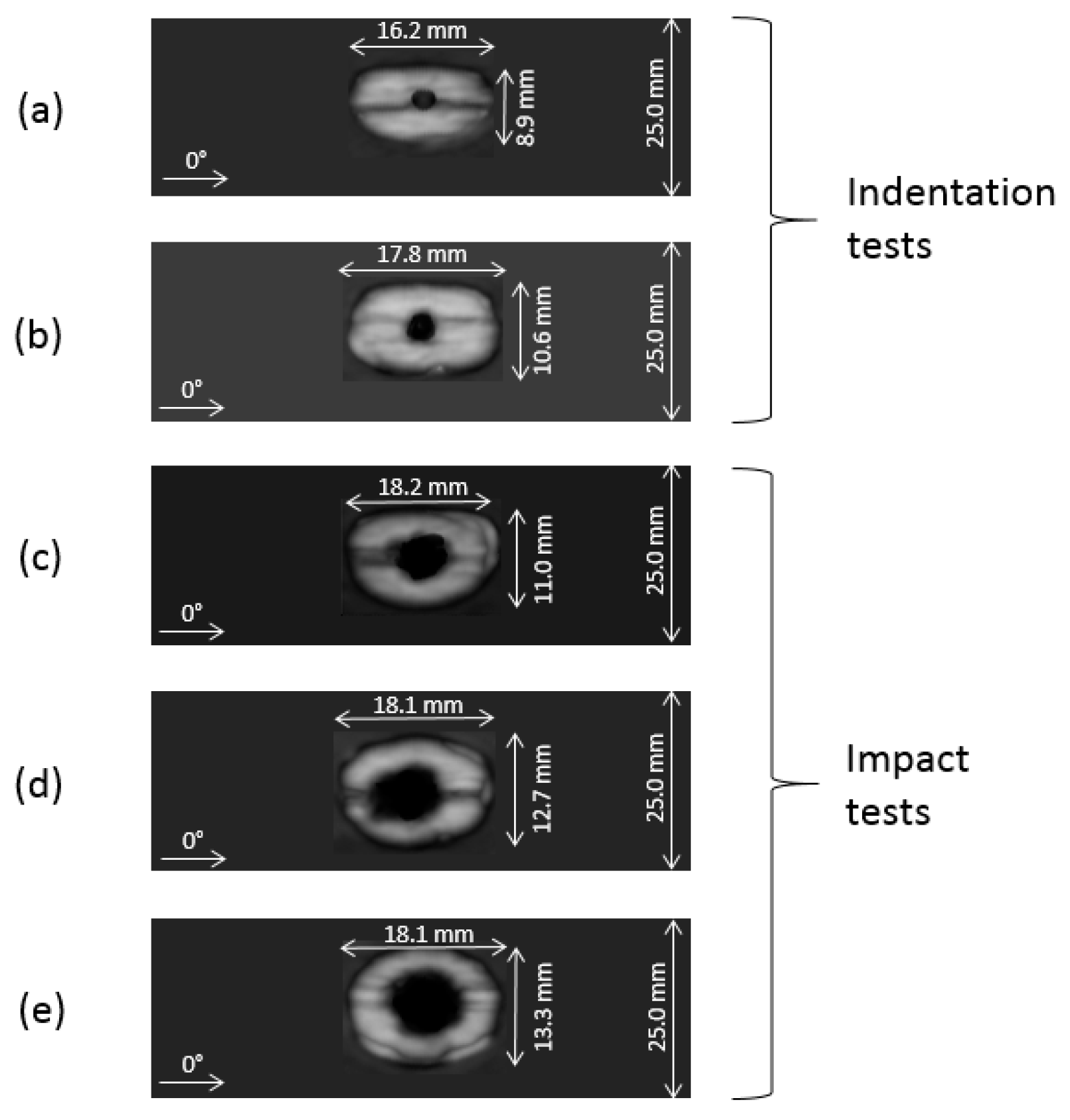
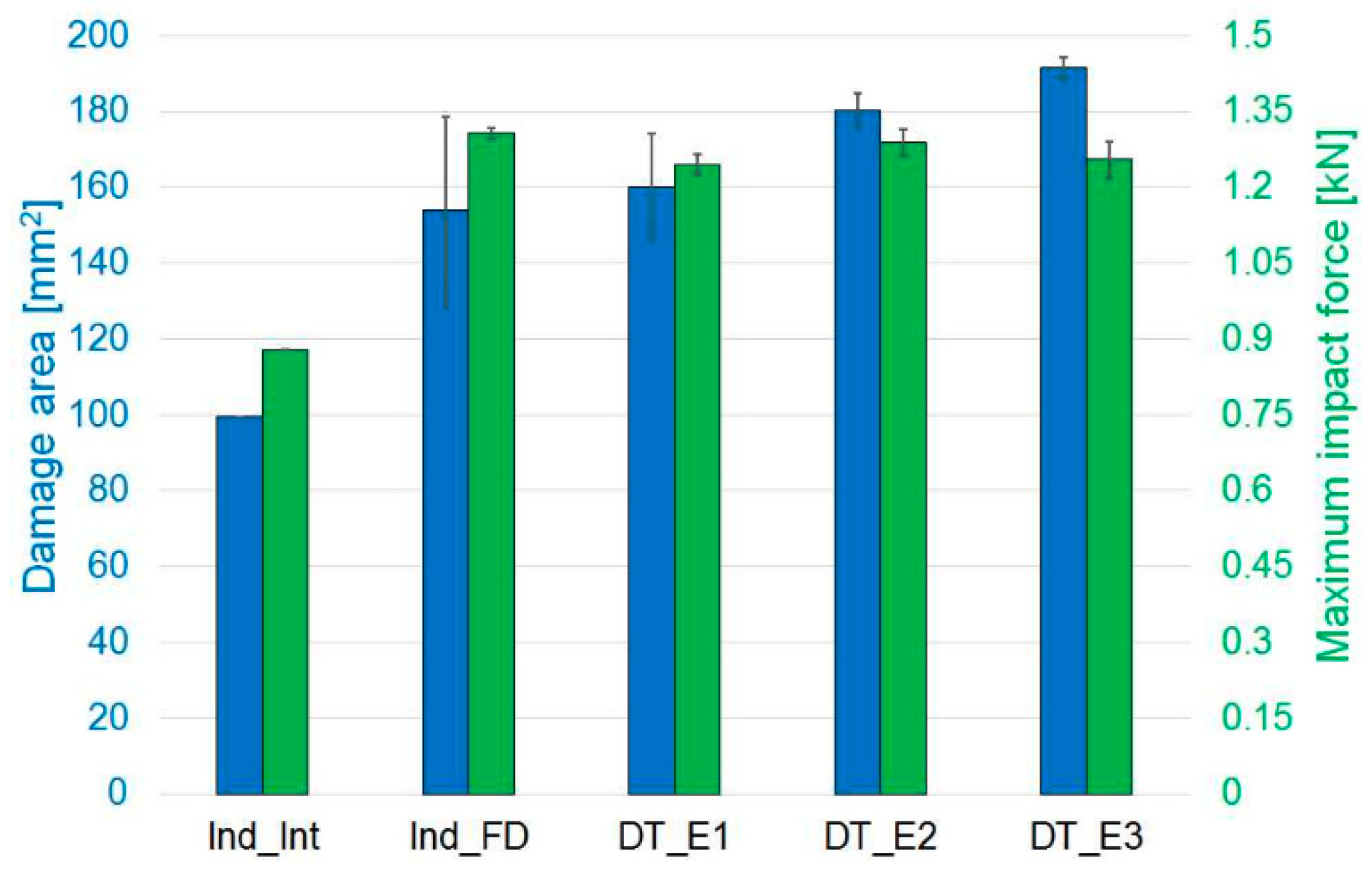


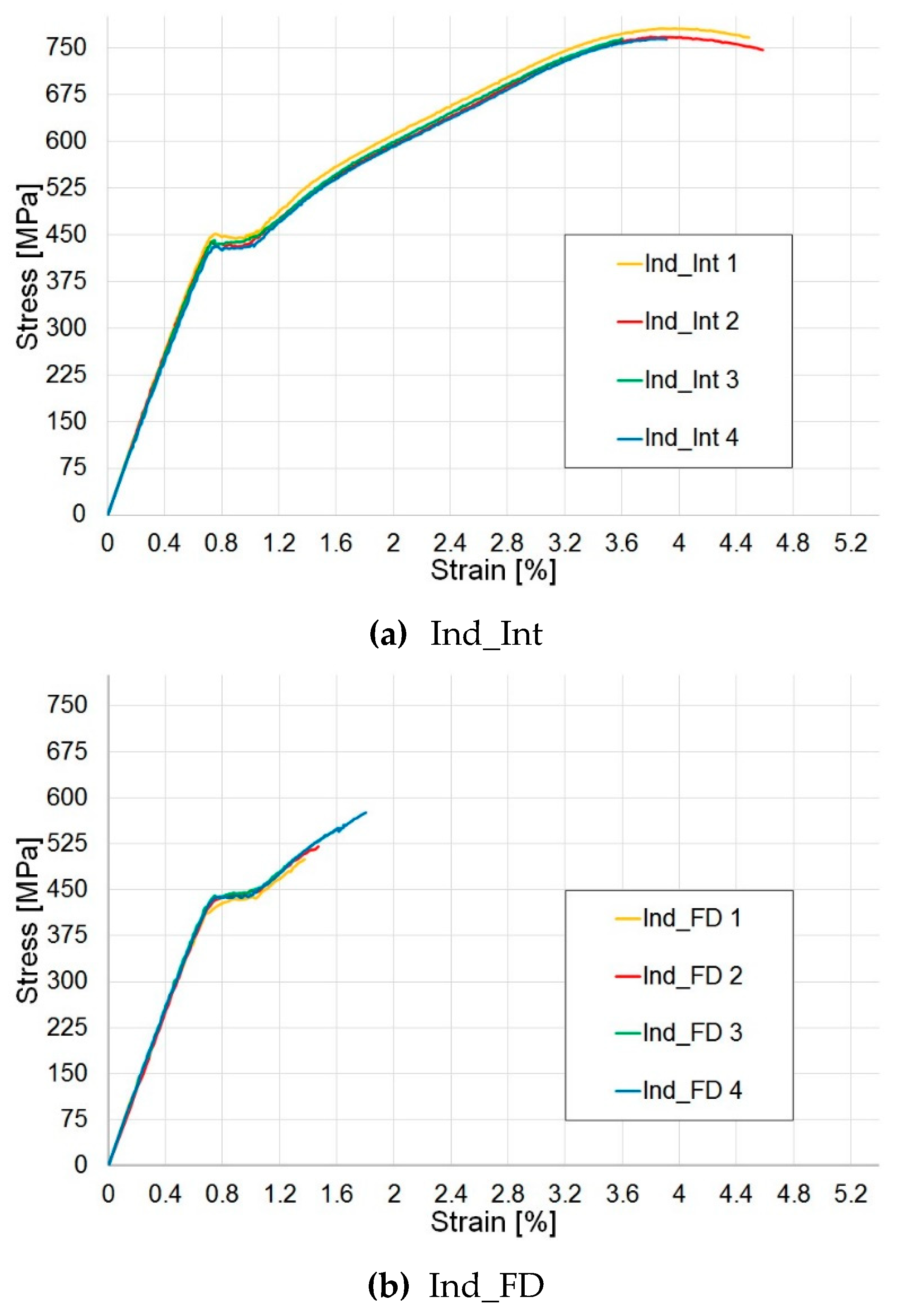
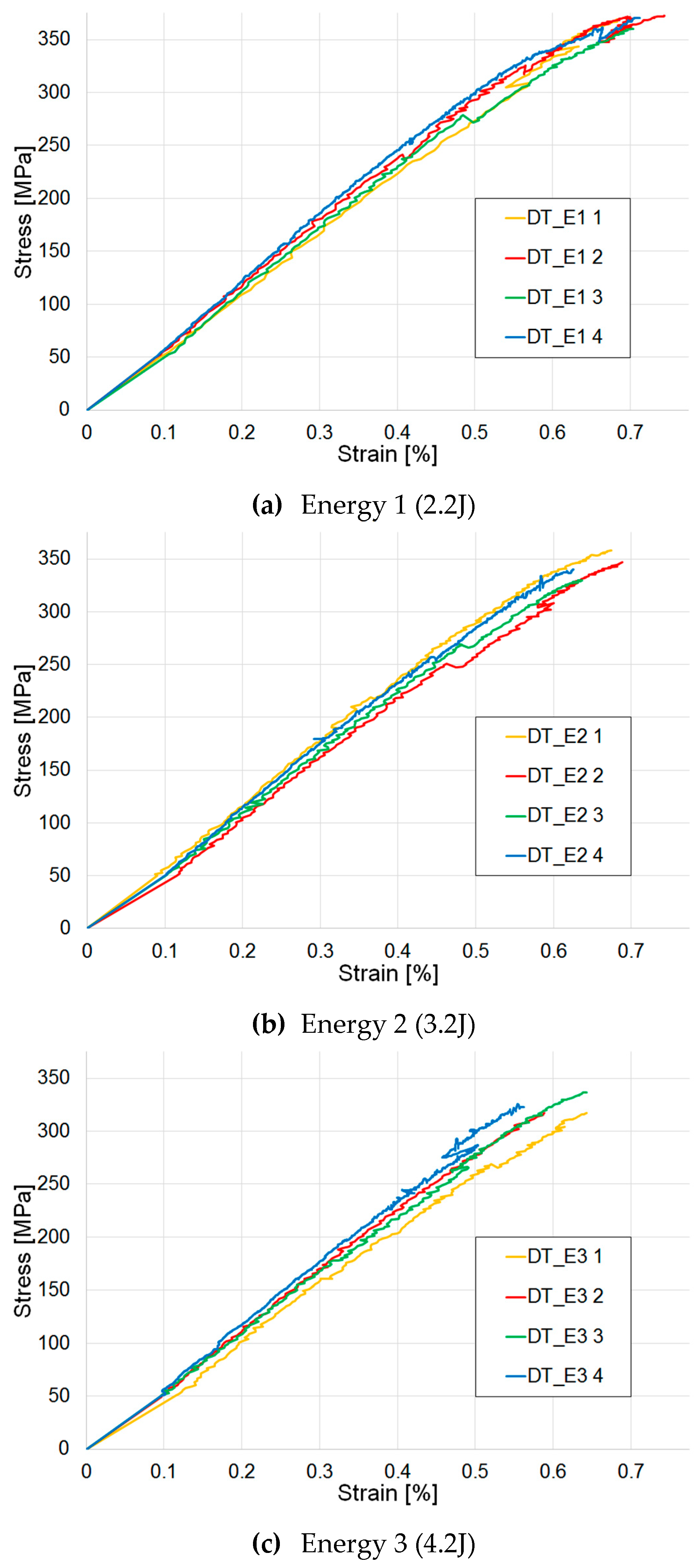
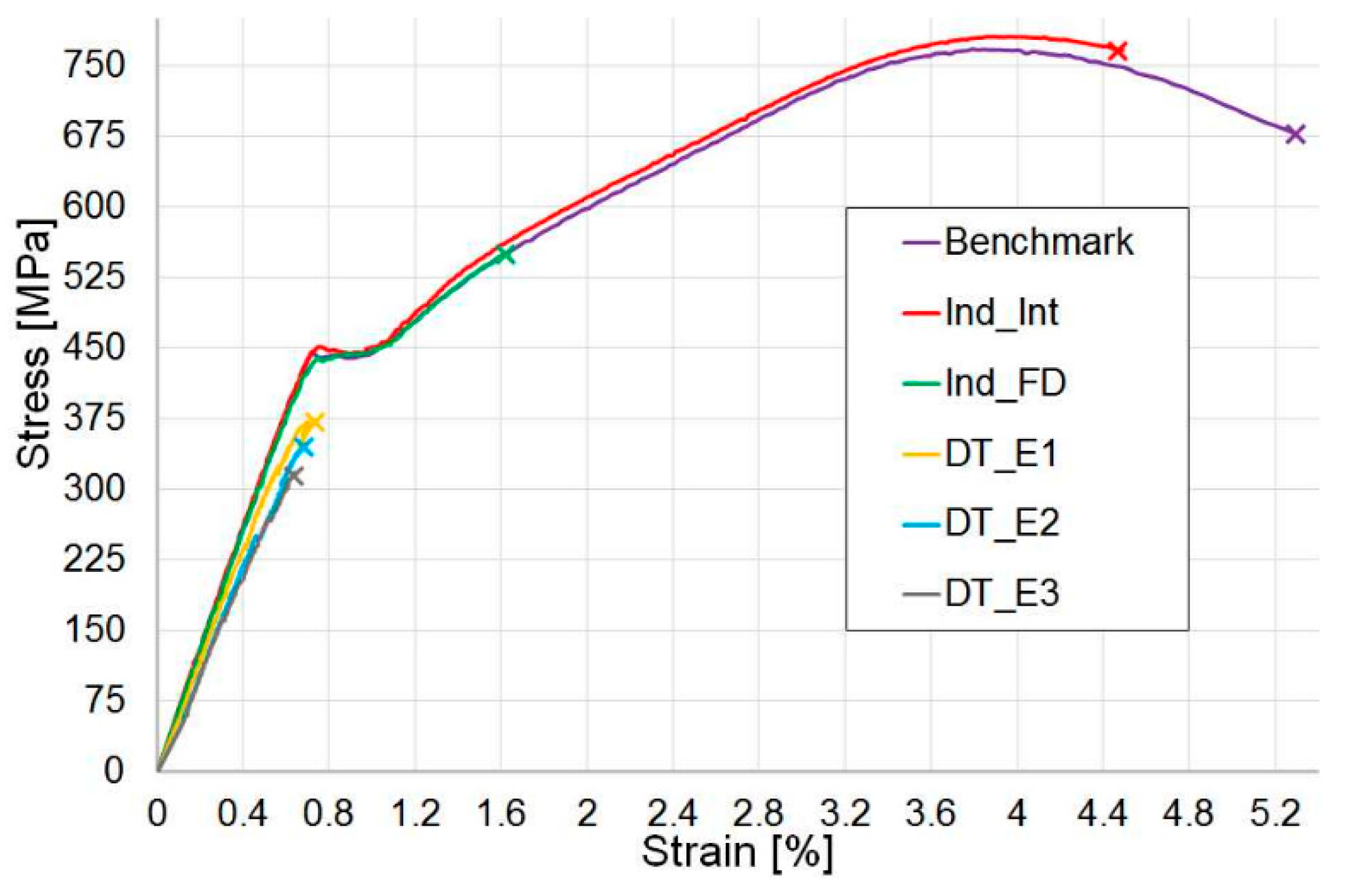
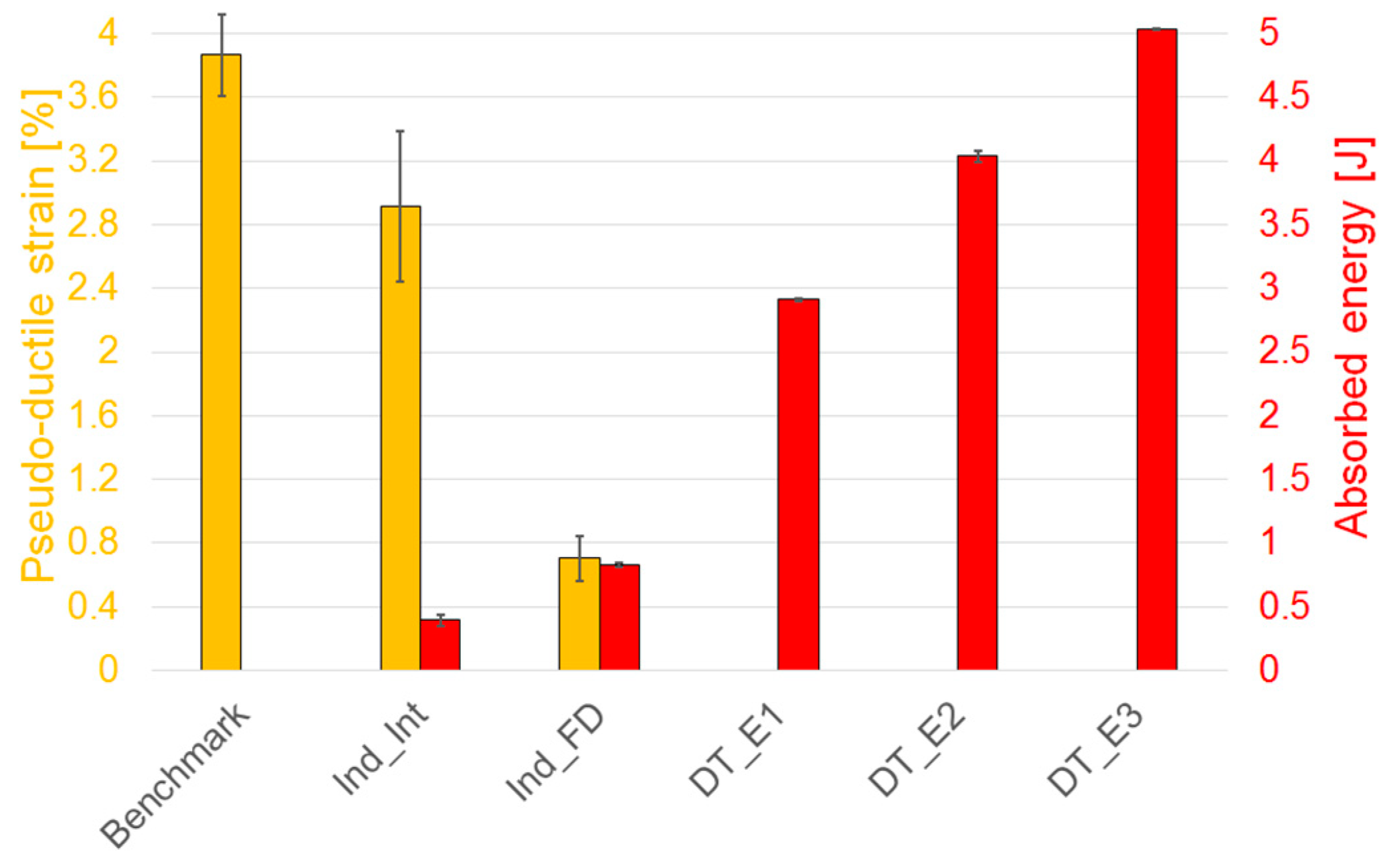



| Skyflex UIN020 [3] | North M55JB/epoxy [18] | |
|---|---|---|
| Fibres properties | ||
| Carbon fibres type | Pyrofil MR60H 24P (12k) | Toray M55JB |
| Manufacturer | Mitsubishi Rayon | Toray |
| Elastic modulus (GPa) | 290 | 540 |
| Strain to failure (%) | 1.9 | 0.8 |
| Tensile strength (MPa) | 5.68 | 4.02 |
| Density (kg/m3) | 1.81 | 1.91 |
| Cured ply properties | ||
| Manufacturer | Skyflex-SK Chemicals | North TPT |
| Fibre volume fraction (%) | 47.8 | 51.3 |
| Cured ply thickness (µm) | 25.4 | 30.8 |
| Initial modulus (GPa) | 140.4 | 277.1 |
| Characteristics | Set-Up |
|---|---|
| Probe designation | Olympus 3.0’’ Spherical PTF |
| Frequency (MHz) | 10 |
| Focal length (mm) | 76.2 |
| Characteristic | Set-Up |
|---|---|
| Technique used | Stereo DIC |
| Software | 8.4.0 |
| Subset size (pixels) | 51 |
| Step size (pixels) | 20 |
| Camera | Imager LX 16MP |
| Lens | Tokina ATX AF 100/2.8 |
| Frame rate | 2 |
| Image Resolution (pixels) | 3603 (w) × 5012 (h) |
| Field of view (mm) | 71.76 (w) × 99.83 (h) |
| Spatial resolution (mm) | 0.398 |
| Displacement resolution (mm) | 0.53 |
| Strain resolution (µε) | 79 |
© 2019 by the authors. Licensee MDPI, Basel, Switzerland. This article is an open access article distributed under the terms and conditions of the Creative Commons Attribution (CC BY) license (http://creativecommons.org/licenses/by/4.0/).
Share and Cite
Prato, A.; Longana, M.L.; Hussain, A.; Wisnom, M.R. Post-Impact Behaviour of Pseudo-Ductile Thin-Ply Angle-Ply Hybrid Composites. Materials 2019, 12, 579. https://doi.org/10.3390/ma12040579
Prato A, Longana ML, Hussain A, Wisnom MR. Post-Impact Behaviour of Pseudo-Ductile Thin-Ply Angle-Ply Hybrid Composites. Materials. 2019; 12(4):579. https://doi.org/10.3390/ma12040579
Chicago/Turabian StylePrato, Alessia, Marco L. Longana, Ambreen Hussain, and Michael R. Wisnom. 2019. "Post-Impact Behaviour of Pseudo-Ductile Thin-Ply Angle-Ply Hybrid Composites" Materials 12, no. 4: 579. https://doi.org/10.3390/ma12040579





